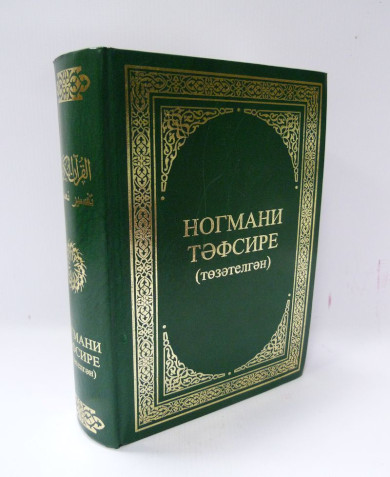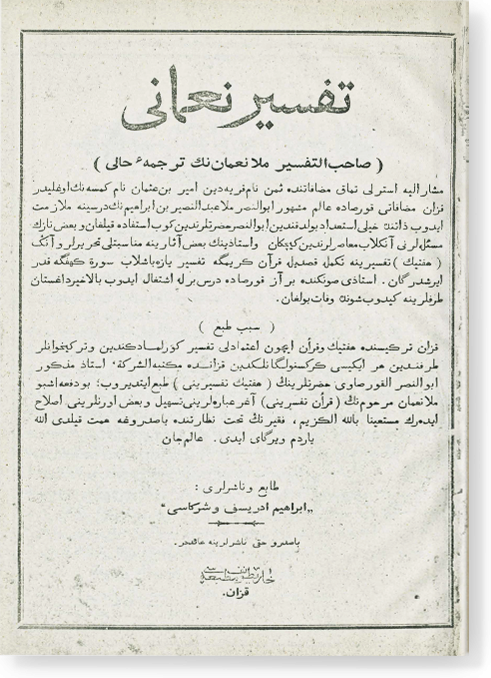by Elmira Akhmetova
The earliest printed Tatar commentaries of the Qur’an produced within the Russian Empire date back to the nineteenth century. In 1861, the first Tatar interpretation of the seventh part of the Qur’an, entitled Haftiyak Sharif (from the Persian haft, or ‘seven’) and authored by a prominent Tatar Muslim theologian and reformer, ʿAbd al-Naṣīr (Gabdunnasir) Qursāwī (1776–1812), was printed. This marked the start of a movement among Tatar intellectuals and religious scholars to produce translations and vernacular commentaries intended to render the Qur’an more accessible to a broader audience.
Qursāwī was one of a number of religious scholars of his time who sharply criticized the excessive symbolic-allegorical interpretation (taʾwīl) of the Qur’an and the abstract polemics associated with the issue of God’s attributes which, in his opinion, was the main reason for the distortion of the original meaning of the Qur’anic verses. In his Haftiyak Sharif, he strived to demonstrate a new approach to the interpretation of the Qur’an. The resulting work inspired later scholars, leading to the production of further Tatar commentaries and translations that followed in his methodological footsteps.
In his Haftiyak Sharif, Qursāwī provided a commentary on the first surah, al-Fātiḥa, and the surahs from al-Fatḥ to the end of the Qur’an (i.e. Q 48–114). Qursāwī’s initiative was later completed by his student Mullah Nuʿmān b. ʿĀmir b. ʿUthmān al-Samānī, who lived during the first half of the nineteenth century. There is not much information available on Nuʿmān’s life, and we do not even know the exact dates of his birth and death. We do know that he was born in the village of Samān in the province of Ufa (present-day Bashkortostan) and received his education and academic training from Qursāwī in the village of Qursa in the Kazan province (present-day Tatarstan).
After Qursāwī died while on Hajj, Nuʿmān assumed the responsibility of editing and finalising the incomplete works of his teacher. Working on Haftiyak Sharif inspired Nuʿmān to write his own interpretation of the remaining parts of the Qur’an that Qursāwī had not included in his commentary and, in due time, this resulted in the two-volume commentary known as Nuʿmāni Tafsire (The tafsīr of Nuʿmāni). In his short introduction entitled ‘The Reasons for Writing this Tafsir,’ Nuʿmān stated that, ‘When Qursāwī had finished translating the seventh part of the Qur’an into Turkic (Tatar) and went to perform the Hajj, he said, “Maybe it would be more beneficial if the entire Qur’an were translated into Tatar.” I could not forget these last words of Qursāwī.’ It is very clear from this statement that Nuʿmān seems to consider his endeavours in interpreting the Qur’an in Tatar as fulfilling the last wishes of his teacher. This impression is consolidated by the fact that Qursāwī’s unfinished Haftiyak Sharif constituted a substantial part of Nuʿmāni Tafsire, as Nuʿmān included this commentary in his own interpretation of the surahs.
Due to the vernacular nature of Nuʿmāni Tafsire and improved access to printing facilities, this tafsīr earned widespread popularity among ordinary laypeople as soon as it appeared. It was published for the first time in 1907 in Orenburg, and again in 1911 by Milliyet Electro-Printing House in Kazan, Russia. In 1959, it was printed again by ʿImād al-Dīn Jamāl al-Dīn in Helsinki, Finland.
Nuʿmāni Tafsire’s renown surged for a second time after the collapse of Soviet ideology in the 1990s. The removal of restrictions on religion led to an increasing desire among Muslims to study and understand the Qur’anic text. In order to fill the existing vacuum and respond promptly to the escalation in public demand for Islamic religious texts, Nuʿmāni Tafsire was printed in Qatar in 1989. Then, in 1991, it underwent a comprehensive revision at the hands of Nurulla Arslani so as to make its text more appropriate for a modern readership: it was transferred into the contemporary Tatar language and Cyrillic alphabet; the interpretations were simplified and made more relevant to contemporary realities; and, in addition, the long stories (riwāyāt) that had been one of the main features of classical tafsīr works, were removed or substantially shortened. This modernised, vernacular version of Nuʿmāni Tafsire has been published in Kazan several times, and has become very popular among Tatar Muslims in the post-Soviet period.
When interpreting the Qur’anic verses in Tatar, Nuʿmān first gives a fragment of the verse or a single word in its original Arabic within brackets and then follows this with a translation and interpretation in Old Tatar (i.e. Tatar written in the Arabic alphabet). Following the lead of his teacher Qursāwī, Nuʿmān mostly avoids excessive symbolic-allegorical interpretation of the Qur’anic verses. Yet, at the same time, when it comes to its methodology and the main sources that were used in the interpretation of the verses, Nuʿmāni Tafsire appears to follow the centuries-long classical tafsīr tradition of Qur’anic exegesis. For example, Nuʿmān refers in the text to the following classical history and tafsīr works: Ibn Athīr’s (d. 1209/10) Jāmiʿ al-uṣūl fī aḥādīth al-rusul (‘The Collection of Precepts in the Collected Traditions about the Prophets); a compilation of six ḥadīth books, namely al-Muwaṭṭaʾ, Saḥīḥ al-Bukhārī, Saḥīḥ Muslim, Sunan Abū Dāwūd, Sunan al-Tirmidhī and Sunan al-Nasāʾī; the tafsīr of al-Qurṭubī (d. 1230); and Qurrat al-ʿuyūn wa-mufriḥ al-qalb al-mahzūn (‘The Joy of the Eyes and the Heart in Sorrow’) by the Hanafi jurist Imām Abū’l-Layth al-Samarqandī (d. 983).
An analysis of the text of Nuʿmāni Tafsire allows us to suggest that it uses the methodology of tafsīr bi’l-māʾthūr (interpretation by means of the transmitted tradition, according to which priority is given to the aḥādīth, the statements of the Prophet and his Companions). This is perhaps the fundamental difference between this work and the other Tatar commentaries and translations that were written at the beginning of the twentieth century by Musa Jarullah Bigiyev (1875–1949), ‘Alimjan Barudi (1857–1921) and Murad Ramzi (1855-1935).
However, although Nuʿmān follows established tradition in his methodology, he does not simply copy the interpretations provided in classical tafsīr works of Islamic concepts such as ribā (‘usury’) and ṣadaqah (‘charitable donation’), but instead interprets them in a broader and more modern sense that reflects new interpretive trends and realities among the contemporary Muslim community in Russia. Thus, some modern scholars such as Artur Azmukhanov classify Nuʿmāni Tafsire as tafsīr bi’l-raʾy or bi’l-dirāyah (i.e. tafsīr undertaken using independent rational reasoning, or ijtihād, to construct an opinion-oriented interpretation of the Qur’anic verses). Tafsīr bi’l-raʾy does not limit itself to classical riwāyāt alone; rather, the teachings of local madhhabs, local languages, and regional culture, literature, and traditions play an important role in the way certain verses are interpreted. Thus, this kind of interpretive process can be called an ijtihād on the part of the author, with the aim of establishing maṣlaḥah (‘common interest’ or ‘public benefit’). Such type of tafsīrs commonly emerge out of necessity of time and regional public demands.
In sum, Nuʿmāni Tafsire has drawn the attention of contemporary researchers in the field of Qur’anic exegesis due to its vernacular nature, more specifically the fact that it is the first Tatar commentary with clear signs of a specific Kazan Tatar dialect. It remains popular until the present day, perhaps because of Nuʿmāni’s ability to interpret the Qur’anic text in a way that is suitable for a particular region and satisfies local needs. The revised, ‘modernised version’ of this tafsīr can be found on the table of every practicing Muslim Tatar in contemporary Russia.





